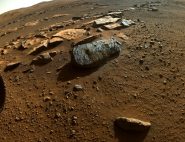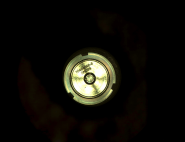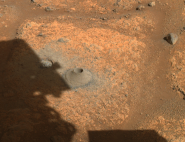CNES projects library
C
I
M
P
S
U
Mars 2020 / Perseverance / SuperCam
Launched on 30/07/2020 from Cape Canaveral, Perseverance landed on 18/02/2021 in Jezero Crater, a site chosen for its geologic diversity and once home to an ancient river delta. Several satellites in orbit around Mars have detected clays and carbonates there, minerals showing that liquid water crucial to life was present over long periods of time. The fine laminated structure of clay also makes it well suited to preserving organic compounds and possibly even signatures of past life.
SuperCam is one of the seven scientific instruments on the Perseverance rover. It is in fact a suite of instruments composed of three spectrometers, a camera and a microphone. SuperCam is an enhanced version of the ChemCam instrument on NASA’s Curiosity rover operating on Mars since 2012.
Like ChemCam, SuperCam is able to analyse the chemical composition of rocks by firing a laser at them—a technique called laser-induced breakdown spectroscopy or LIBS—to produce a colour picture. It is also able to detect minerals and any organic molecules by Raman and infrared spectrometry. The laser is currently investigating rocks from a distance of 7 metres and the Raman spectrometer from 12 metres, while the IR spectrometer and the camera are capable of seeing out to the horizon.
Perseverance also collects and stores samples of Martian rock inside hermetically sealed vessels for later recovery by NASA/ESA Mars Sample Return (MSR) missions and their return to Earth. SuperCam is crucial to selecting these samples for subsequent analysis on Earth to look for traces of ancient life.
Perseverance is assisted in its search for samples by the first Martian helicopter, named Ingenuity.
The mission applies the planetary protection recommendations of COSPAR. Before departure, Perseverance was biologically decontaminated to preserve the biological conditions on Mars and avoid false positives when analysing samples. These samples will be returned to Earth following strict confinement and sterilization procedures to avert any biological threat to Earth’s biosphere.
SuperCam is the result of close collaboration between the U.S. Los Alamos National Laboratory (LANL) and the IRAP astrophysics and planetology research institute (France), with a contribution from the University of Valladolid (Spain). Design and construction of the French contribution to SuperCam, called the Mast Unit, was coordinated by IRAP with CNES oversight. Other French laboratories—the Midi-Pyrenees Observatory (OMP), the LAB astrophysics laboratory in Bordeaux, the LESIA space and astrophysics instrumentation research laboratory and the LATMOS atmospheres, environments and space observations laboratory—also contributed elements of the instrument. SuperCam was delivered to LANL in June 2019.
Mission's news feed
-

NASA’s Perseverance Rover Collects Puzzle Pieces of Mars’ History
NASA’s Perseverance Mars rover successfully collected its first pair of rock samples. After collecting its first sample, named “Montdenier,” Sept. 6, the team collected a second...
September 10, 2021
-

Perseverance Rover Collects First Mars Rock Sample
NASA’s Perseverance rover today completed the collection of the first sample of Martian rock, a core from Jezero Crater slightly thicker than a pencil. A historical first!
September 7, 2021
-

NASA’s Perseverance Team Assessing First Mars Sampling Attempt
Data sent to Earth by NASA’s Perseverance rover after its first attempt to collect a rock sample on Mars and seal it in a sample tube indicate that no rock was collected during...
August 6, 2021


